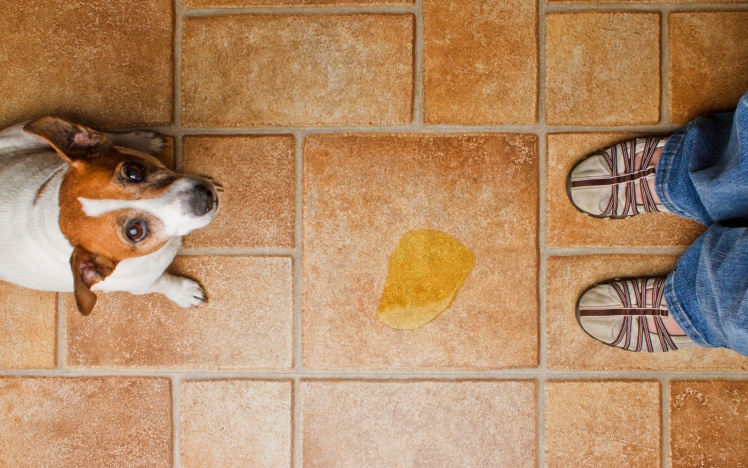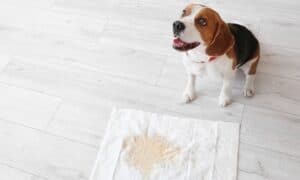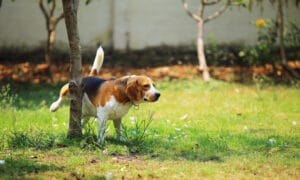“This post contains affiliate links, and I will be compensated if you make a purchase after clicking on my links.”

By Certified Dog Trainer, Steve Reid
A well-structured housebreaking plan can (in most cases) be utilized with any dog. We should be able to successfully housebreak any puppy or older dog who has not been housebroken before. Housebreaking a dog is very simple, but not necessarily easy. It takes a lot of patience and diligence on the part of the owner. I stress to owners the importance of being super vigilant in following through on every step of the protocol and putting forth a lot of effort initially, in order to successfully housebreak your dog sooner rather than later. It’s better to work hard for a couple weeks and have a fully housebroken dog, then to slack off and have a dog that is still having accidents in the home 6 months down the road. One of America’s foremost business experts, Jim Rohn, is famous for saying, “There are two types of pain you will go through in life, the pain of discipline and the pain of regret. Discipline weighs ounces while regret weighs tons.” I prefer you to be disciplined and follow all the steps and have a housebroken dog, then to regret it for months.
Housebreaking Cheat Sheet:
1. Check overall health.
2. Determine realistic amount of time between visits outside.
3. Set and record predictable feeding (using a “filler free” premium food) and bathroom schedule.
4. Crate train dog.
5. Maintain visual eye contact.
6. Importance of timing for correction and praise.
Check Overall Health: First and foremost, it is critical to make sure the puppy or older dog is in good overall health. It would be unfair and ineffective to try and implement a housebreaking protocol when there is an underlying medical issue. It is important to have your Veterinarian do a thorough medical checkup (physical exam, blood work, stool and urine sample, etc.). Once we have ruled out any medical issues, we can move on with the process.
Side note: If your dog is housebroken, and has not had an accident in the home for years and all of a sudden, it starts having accidents; this can be a sign of a medical or territorial issue. The first thing I would do in that situation is take the dog to a veterinarian to rule out a medical cause, and only after that begin addressing housebreaking from a training point of view.
Determine Starting Intervals: The first step in the housebreaking protocol is to establish a starting point for how long your dog can realistically and appropriately hold their bowels or urine. If you have already noticed a trend, such as your dog can go 3 hours without an accident, then start with that. If not, I like to use a conservative formula in order to set both dog/puppy and owner up for success. This involves starting with shorter intervals in the beginning and progressing from there.
I start dogs at their age in months minus 1 hour. For examples, a 4 month old puppy = 3 hours between trips outside. Dogs over the age of 12 months can typically hold it longer. Every dog is different, but if they had no prior housebreaking experience, I would start at short intervals and gradually progress (even with an older dog). When in doubt, start out at 2-hour intervals and progress from there. Once you’ve determined an appropriate starting point, then you can move onto the next step: Placing the dog on a predictable schedule for feeding as well as access to the outside.
Establish a Predictable Schedule: I have all clients use an actual chart (an hourly segmented schedule like you would use for work appointments) in order to record the exact feeding times, times of accidents in the home (distinguish if it was pee or poop), and mark the times the dog was let outside and if they went to the bathroom during this time (again, mark if it was pee or poop). Having a clear and detailed schedule makes troubleshooting any future issues significantly easier. It is important to keep a new schedule each day, so we can have an objective view of progress.
As I said earlier, it’s better to start out more conservatively and gradually increase duration between trips outside. For example: If your dog seems to have no accidents for 3 hours right now, I would take a step back and let them outside every 2.5 hours. Once she has not had any accidents for two – three consecutive days, then increase the duration to 3 hrs. Once your dog has been accident free for 2-3 more consecutive days at the 3-hour interval, then increase it to 3.5 hours, and so on. If you notice a pattern in which accidents are occurring, that’s when routines will need to be altered.
Setting a predictable feeding schedule is also essential to a successful housebreaking protocol. I NEVER free feed a dog (allowing them free access to their food so they can eat throughout the day whenever they want). Most adult dogs are fed twice per day, one a.m. and one p.m. feeding. Puppies typically eat more frequently (3 times per day). Consult with your Vet to see how often they should eat. Predictable feeding helps lead to predictable bowl movements.
I always feed dogs a premium high quality dog food that is free of grains, common allergens, and added fillers. Not only do I believe this to be healthier for my dogs, but the food I use has not been associated with any of the recent pet food recalls. Using a “filler and additive free” food also decreases the amount of stool the dog produces, as we are using better quality ingredients that the dog’s body absorbs and digests. Decreased stools = easier housebreaking.
Also note: Dogs are more apt to have an accident when stimulated. Stimulation can be in the form of play, a walk outside, or a guest entering the home. These are prime opportunities for your dog to have an unexpected accident, so make sure to be especially aware during these times. Either let the dog outside right before or after these times or be prepared to catch the dog in the middle of an accident and let them outside.
Crate Train the Dog: I believe that all dogs should be properly crate trained. Not only is this a good household management tool and a way to keep the dog safe at night or when you are not home, but it is a very important component to housebreaking.
The dog or puppy should be in its crate at night, when you are not home, and when you do not have direct eye contact on the dog. The goal with crating is for the dog to be less apt to have an accident where it is living and sleeping. We are trying to utilize the dog’s natural instinct to not soil where it is staying. This will help to prevent accidents and help to gradually increase the time intervals between bathroom trips outside. It is important that the crate not be so large that the dog (this is especially true for puppies) can move to one side of the crate, go to the bathroom, and then lay on the other side of the crate. That would undermine the whole purpose of the crate. If the crate is too big, then you can consider using the partition that the manufacturer typically supplies with the crate (make sure the dog has appropriate space to stand up, move around and stretch, but not an excessive amount of room).
Maintain Visual Eye Contact: A critical element to housebreaking is that she must be within your sight at all times. The reason for this is: if the dog is having an accident, you can immediately catch her in the act and run her outside. Direct eye contact means you can visually see the dog. That does not mean the dog is in the next room and you are quickly going to the kitchen. That is a prime opportunity for an accident to occur. You must be able to see the dog at all times in order to scoop them up and bring them outside.
Helpful Hint: I like to leave a short leash on the dog when they are out of the crate and I have visual eye contact on them (NEVER when they are left unsupervised or when they are in their crate). This makes it a lot easier to quickly grab the leash and direct the dog outside when they are in the middle of having an accident. Many owners find it hard and waste a lot of time when it comes to trying to pick the dog up and put the leash on them while they are trying to stop an accident and bring them outside. Preemptively having the leash on is a huge help. Just make sure the dog does not chew on or eat the leash, if they do, then you need to either correct that behavior or not allow them to wear the leash in the house.
Importance of Timing: Timing is VERY critical to housebreaking. We cannot correct or tell a dog “No” after the accident has already occurred. That means, if the dog has an accident when you are at work or in the other room, and you come back, it is too late to correct the dog for that. You simply need to stay quiet, and clean up the mess. All praise and correction must come within 1.5 seconds of the action. If you are outside with the dog and they go the bathroom in the desired location, you need to immediately praise (verbally or petting) and/or give them a treat. You can’t wait until you get in the house to do so; that is too far after the desired act of going to the bathroom to reward.
Now, you might be thinking, I can’t watch my dog every minute I am home, I have a life and things to do. I completely understand and totally agree. In that case, if you can’t have at least one eye on your dog the entire time they are out of the crate, then you need to put the dog back in the crate for that time. If you need to cook dinner, take a shower, get ready for work, and you can’t have the dog directly with you and within eyesight, then you need to put the dog in the crate. Dogs can be very opportunistic. I have had clients who let their dog off leash in the same room as them, and they think they are doing a good job watching the dog, but the dog walks behind the sofa or behind a table and quickly has an accident. Not only is this reinforcing the undesired behavior (having an accident in the home), but we were not able to stop it and lost the opportunity to praise them for when we brought them outside and they went (remember, we can only correct or praise within 1.5 seconds of the action – no later).
Please Note: When your dog does have an accident anywhere in the home (and your dog will have accidents, it is inevitable and to be expected), make sure to thoroughly clean the surface with appropriate cleaner. It is essential that the area where the accident occurred (both pee and poop need to be cleaned) is cleaned so the dog does not smell itself there and think that is a place to go to the bathroom. It is helpful to bring the dog to the same spot where they have gone to the bathroom outside, so they smell their scent on that same tree, bush, or patch of grass, but you do not want your dog to smell their accidents in the home.
Steve Reid is a Certified Dog Trainer and owner of S.R. Dog Training in Somers, NY. For more information about S.R. Dog Training, visit www.srdogtraining.com or www.facebook.com/SRDogTraining.






















York Griffith
says:How long should I do this for?
Ask the Trainer: Solving Common Housebreaking Problems – The Dogington Post
says:[…] My previously written housebreaking article can be found here. […]
Ask the Trainer: Solving Common Housebreaking Problems – The Dogington Post
Bonnie
says:Thanks for the tips! i will be using them. I have a 3 yr old that “forgets” to not pee inside sometimes, and I will be getting a new puppy soon. 🙂 So hopefully this will help.
Lorrie Oliver
says:Could you please tell us what brand of dog food you buy so we might try it too?
Hi Lorrie,
That’s a great question. I prefer the puppy and adult dog food, as well as treats from: idealdogfood.com
I have found that they produce very high quality products which can help to positively influence a dog’s behavior, energy level and overall health/longevity.